Continuing my postings of these rare Fleischer Studio promotional illustrations – this time from the November and December 1937 issues of in-house trade publication Paramount Sales News.
As the panels appeared weekly once again – ironically, emphasizing the intense labor of animation production – we bring you the conclusion of Eli Brucker’s memories of the Fleischer strike. -Thad

“The sympathy of the people was generally with the strikers, who were mostly young people, some with families to support. A neighboring landlord allowed them to use one of his empty lofts for their nearby strike headquarters. The pickets took their turns at the line, and they went to rest in that big cool loft. They had their lunches there and planned the next day.”
“The first day of the strike, when pickets formed their line, they marched around the complete building, and some reporters gathered around and started to interview the pickets. This did not please the management, and it caused them to call the police. The officers took some of the strikers to the station where a few of them spent the night in the lock-up.
But instead of decreasing unfavorable publicity, it had the effect of creating sympathy for the young striking artists, something that the management did not care for.
After the first evening, the picketing was limited to a few strikers at each of the two building entrances only.
The morale of the strikers was good, but receiving strike benefits of only fifteen dollars a week, was very difficult for them. I, not being a member of the union and not a striker, received no financial benefits, no matter how small. But I did get the benefit of knowing that I did the right thing, while the rest of the animators had the feeling that they were concerned selfishly only with themselves, and I could see their guilty feeling whenever we met.
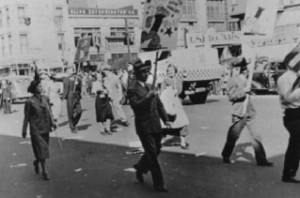
“At the head of the strikers was Lou Appet, a young inbetweener. He inspired confidence in his leadership. Now we see each other occasionally and we consider ourselves friends. He had a job as business agent for the Hollywood cartoon animator organization. Just recently he retired as have a number of the older workers in that field.”
“Shortly after the start of the strike, a hearing was held by the Labor Board. The referee conducted it, and it stretched out for a number of days. The Fleischers had Louis Nizer for their attorney. Mr. Nizer had the reputation of being one of America’s top trial lawyers. In later years he wrote a couple of best-selling books on how he helped to obtain justice for some impoverished but deserving people. But now he was representing those in power, namely his clients.
Mr. Nizer was not the flamboyant type. He spoke very quietly, and people had to pay attention to get his every word. When a witness from the opposing side was on the stand, Nizer would pick at every detail that might be to his advantage. Too, he was always well prepared. Evidently he habitually took care of his homework. And whether one was for him or against him, Nizer got his point across. Just watching him was an education in legal procedure.
However, not much later, it was the decision of the Labor Board to have an election of the Fleischer assistant workers to be held. I still wonder on whose side Mr. Nizer’s sympathy actually leaned.
Of course the strikers won the election, and now it was up to them to make an agreement with the Fleischer management, and that was a drawn-out process.
There was a pressing need for the strikers to get their brother unions to help them in a financial way. A committee to visit these unions was formed, and it was busy about every evening with this work.
One evening I was asked by this committee to join them on what they considered their most important call. It was a well established and prosperous union. The Fleischer strike delegation wanted to make a good impression there, so they asked me to come along.
When we entered their meeting hall, their chairman asked all his members to stand up and greet us, which they did with precision, and the strikers were asked to tell their story. This was very ably done by Lou Appert.
The committee was thanked and told that a check would be sent the following day.
All the Fleischer strikers congratulated themselves. They felt that they had made an excellent appeal and waited the arrival of the check.
When it came it was sort of a bombshell, but in reverse. It was a tiny sum, much less than smaller unions donated by just passing the hat around at their meetings. The strikers felt that the small unions had big hearts while the big one had a tiny pumper in its chest.
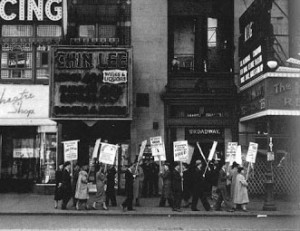
“Being that most of the strikers besides wanting to win, had desires to improve themselves professionally, they were interested in learning more about animation so that they could advance when they started working again.”
“To answer that desire and to lift their spirits I planned several lectures on cartoon animation and had each talk illustrated by an appropriate chart. I drew these explanatory charts and they went over very well. The inbetweeners, especially, found these lectures and charts very valuable. I had the charts photographed and they are reproduced in this book. Perhaps others, too, will find them of value. [TK: Sadly, I don’t have them!]
The strikers made attempts to receive aid and support in their struggle from political figures as well. Their committee was invited by a local congressman to visit his home, and I was asked to come along. The delegation arrived and was seated in his living room. The congressman entered and placed himself in a doorway leading to the rest of the apartment. In short order he started to tell the committee as to what a fine representative he was and hat he could do for the workers. When he spoke, instead of looking at his guests, he constantly looked back as if he was seeing and talking to someone in the other room as well. He posed and preened himself and struck a heroic posture. We were puzzled by these actions. The strikers wondered when he would give them the opportunity to tell of their problems. After a long and irrelevant speech, he excused himself, and saying that he would be back in a few minutes, he left the room. One of the delegation got up and went to the door to see what the congressman was looking back at so constantly. However, no one was in the next room. But hidden from our view was a full length mirror placed so that only he could see his reflection. Evidently he was interested in seeing what a glorious heroic figure he appeared to be.
After leaving his home, all of us realized that the committee could expect no help whatsoever from this congressman. He did, however, supply us all with a grand laugh at his colossal vanity.
But finally the strike was settled, and the Fleischer Studio was to move to Miami, Florida. All of the workers, including the former strikers, were to be moved via railroad to the new studio there. The strike committee insisted that I, like the other workers, be given a year’s contract and that is how much longer I worked for the Fleischers.”
Please click each illustration to enlarge image.
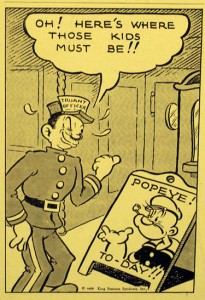
Directly below is a sample of a cartoon short the Paramount salesmen were pushing to theaters at the time these promotional pieces appeared in print.
POPEYE THE SAILOR MEETS ALI BABA AND HIS FORTY THIEVES (Nov. 26th 1937)




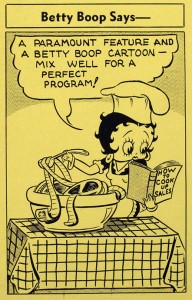




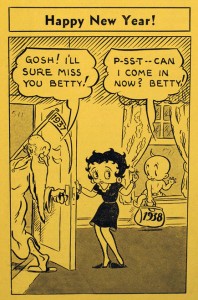
 THAD KOMOROWSKI is a writer, journalist, film restorationist and author of the acclaimed (and recently revised) Sick Little Monkeys: The Unauthorized Ren & Stimpy Story. He blogs at
THAD KOMOROWSKI is a writer, journalist, film restorationist and author of the acclaimed (and recently revised) Sick Little Monkeys: The Unauthorized Ren & Stimpy Story. He blogs at 

























































Wait, Betty is 16?
Mmmkay…
The remembrances by Brucker are terrific. Any time you can read first-hand insight is a bonus.
Funny that Popeye would later be fighting those Japs in WWII.
I’m pretty sure that audience is suppose to be Chinese. The ponytail (specifically known as a queue) was mostly unique to the certain Chinese peoples (the Manchu) with the rest of the head shaved as seen in the advert.
Westerners of the era used such uniquely Chinese styles (Queued, long slender mustaches, traditional caps) to make such characters easily recognizable as Chinese. Stereotypical to be sure, but it got the job done. Part of the reason such a depiction is no longer used is that such traditional dress is now archaic. Even in the day that cartoon was drawn the wearing of the queue by the Manchu had fallen out of favor but still hung on for a while in Western caricature.
Once again, Thad, thank you for the Eli Brucker material.
So it took almost 4 years for Betty in the promo art to reflect the spayed Betty on the cartoon screen.
Thank you. I am Eli Brucker’s granddaughter. Although I remember some of the things he and my mom told me, I learned a lot reading this.